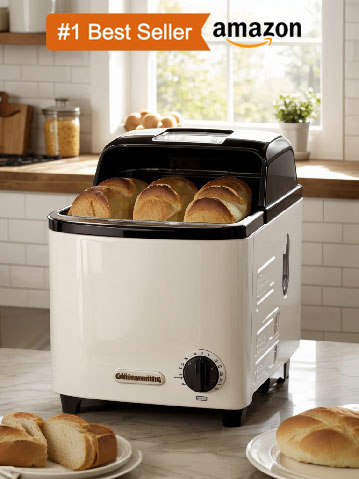Can I Use Homemade Yeast In Bread Machine
Making bread at home is a rewarding experience that can result in delicious loaves. Many recipes call for yeast, and using a bread machine makes the process even simpler. While store-bought yeast can be used in a bread machine, homemade yeast is also an option.

Use instant yeast, rather than active dry yeast, when making bread in a machine.
Instant yeast is ideal for bread-making in a bread machine. It is also known as "rapid rise" or "bread machine yeast," and is a type of dry yeast specifically formulated for use in bread machines. Unlike active dry yeast, which needs to be proofed in warm water before use, instant yeast does not require proofing and can be added directly to the dry ingredients in the bread machine.
This helps to speed up the bread-making process, since there is no need to wait for the yeast to become activated. It also helps ensure that the dough rises evenly and quickly, resulting in a better finished product. Instant yeast is a great choice for those who want to make bread quickly and easily in a bread machine.
Make sure to use the correct amount of yeast; too much will cause the bread to rise too quickly, while too little will cause the bread to be dense.
Yeast is a key ingredient in baking bread that is essential for the dough to rise. Without it, the bread will remain dense and heavy. When using yeast to make bread, it is important to use the correct amount.
Too much yeast will cause the bread to rise too quickly, resulting in an uneven texture with large pockets of air within the loaf. Too little yeast will cause the bread to be dense and not rise properly. It is best to use the amount specified in the recipe you are using. To determine the amount of yeast needed, refer to the instructions on the yeast package or consult a cookbook for more specific amounts. A kitchen scale can also be used to measure out the exact amount of yeast for accuracy. Using the proper amount of yeast is an important step for ensuring a successful loaf of bread.
See also: Adding Flour Or Water To Dough In Bread Machine
If using homemade yeast, it should be stored in the refrigerator and used within 2 weeks.
When making your own yeast at home, it is important to store it properly for the best results. It is recommended to store homemade yeast in the refrigerator. This will keep it fresher for longer and help prevent it from becoming contaminated by bacteria or other microorganisms.
It is best to use the yeast within two weeks of making it, as it may start to lose its potency after that time. When using homemade yeast, remember to keep it away from heat and light, as this can also affect its potency. Additionally, make sure that any utensils used when handling the yeast are properly cleaned and sanitized before and after use. With proper storage and precautions, homemade yeast can make a great addition to your baking projects.
See also: Different Types Of Banana Bread In Bread Machine
Make sure to use the right type of flour for the recipe; bread machine recipes typically call for bread flour or all-purpose flour.
Bread machine recipes typically require specific types of flour, as different types of flour can affect the texture, rise, and flavor of the finished product. For most bread machine recipes, bread flour or all-purpose flour is best suited for the task. Bread flour is a high-gluten flour that is made from hard wheat and contains more protein than all-purpose flour.
It is ideal for making bread, as it helps the dough rise and gives it a chewy texture. All-purpose flour is made from a blend of hard and soft wheat and is a good choice for making a wide variety of baked goods. It is less expensive than bread flour and can be used for most bread machine recipes. However, it does not have the same power to make dough rise, so the finished product may be denser than with bread flour. Therefore, when using a bread machine, it is important to use the right type of flour to ensure a successful result.
See also: Other Things To Make In A Bread Machine
Different bread machines may require slightly different measurements of ingredients; carefully read the instructions for your specific machine.
When using a bread machine, it is important to follow the instructions for the specific machine. Different machines can require different measurements of ingredients, so it is essential to read the instructions carefully. When adding ingredients to the bread machine, it is important to use the accurate measurements that are specified in the instructions.
Adding too much or too little of an ingredient can significantly change the consistency and flavor of the bread. Furthermore, it is important to make sure that the ingredients are added in the correct order as specified in the instructions, as this can also affect the finished product. Following all of these steps can help ensure that the bread turns out perfect every time.
See also: Bread Machine Garlic Bread Without Powdered Milk
Allow the dough to rise until doubled in size before baking; this usually takes between 1 and 2 hours.
When making bread, it is important to allow the dough to rise before baking. This process is known as proofing, and it allows the dough to expand due to the gas produced by the yeast. To allow the dough to rise, place it in a warm and draft-free environment, such as a bowl covered with a damp cloth.
The dough should be allowed to double in size, which usually takes between 1 and 2 hours. During this time, the yeast will work its magic and create an airy and light dough. After this process is complete, the dough is ready to be shaped and baked. Allowing the dough to rise before baking is an essential step in creating a delicious finished product.
See also: How To Fix Morphy Richards Bread Machine Drive Shaft
Be sure to knead the dough for the proper amount of time; this should be listed in your bread machine instructions.
Kneading the dough for the proper amount of time is a key step in making successful bread in a bread machine. Kneading helps to develop the gluten in the dough, which gives the bread structure, texture, and strength. Kneading also helps to evenly distribute the yeast throughout the dough, resulting in a consistent rise.
The amount of time required to knead the dough depends on the type of bread being made and the specific settings of your bread machine. To ensure that your bread turns out perfectly, you should always check the instructions that came with your bread machine and follow the recommended kneading time listed there. If you're using a recipe from another source, make sure to consult that recipe's instructions as well. Kneading the dough for too little or too much time can result in a loaf that doesn't rise properly or has a dense, gummy texture. So it's important to pay close attention to kneading time instructions for best results.
Add any additional ingredients, such as herbs or nuts, after the dough has kneaded for several minutes.
Adding additional ingredients to the dough can be a great way to enhance the flavor and texture of your finished product. After the dough has been kneaded for several minutes, you can start to incorporate additional ingredients like herbs, nuts, dried fruits, or seeds. These ingredients will add a unique flavor to your dough and can help to give it a more complex taste.
When adding these ingredients, it is important to do so gradually in order to ensure that they are evenly distributed throughout the dough. Additionally, you should always make sure that any nuts or seeds you are using are finely chopped or ground so that they mix more easily with the dough. Once all of the ingredients have been added, you can knead them together until they are fully incorporated. This will ensure that all of the flavors have been blended together and that your dough is ready to be used in whatever recipe you have in mind.
Grease the inside of the bread machine before adding ingredients to prevent sticking.
Greasing the inside of a bread machine before adding ingredients is an essential step in the bread-making process. This is because it prevents the dough from sticking to the sides of the machine as it kneads and rises. To grease the inside of the bread machine, use a non-stick cooking spray or a light coating of vegetable oil.
Start by lightly spraying or wiping down the interior surfaces of the machine. Pay special attention to any crevices, as these are more likely to cause sticking. Once the entire interior is lightly coated, you can add in the ingredients as specified by your recipe. Greasing the inside of the bread machine ensures your dough will come out easily and evenly when finished, and prevents any messes or waste.
Always use a thermometer to check the internal temperature of the finished bread; it should be at least 190°F before removing it from the machine.
It is important to use a thermometer to check the internal temperature of the finished bread before removing it from the machine. The thermometer should be inserted into the center of the loaf, and the internal temperature should be at least 190°F in order for the baking process to be complete. This ensures that the bread is baked properly and the yeast has had enough time to activate and help the dough to rise.
If the temperature is below 190°F, then the bread will be undercooked and will not have reached its full potential. A thermometer is an inexpensive and easy way to ensure that your bread turns out perfectly every time.





